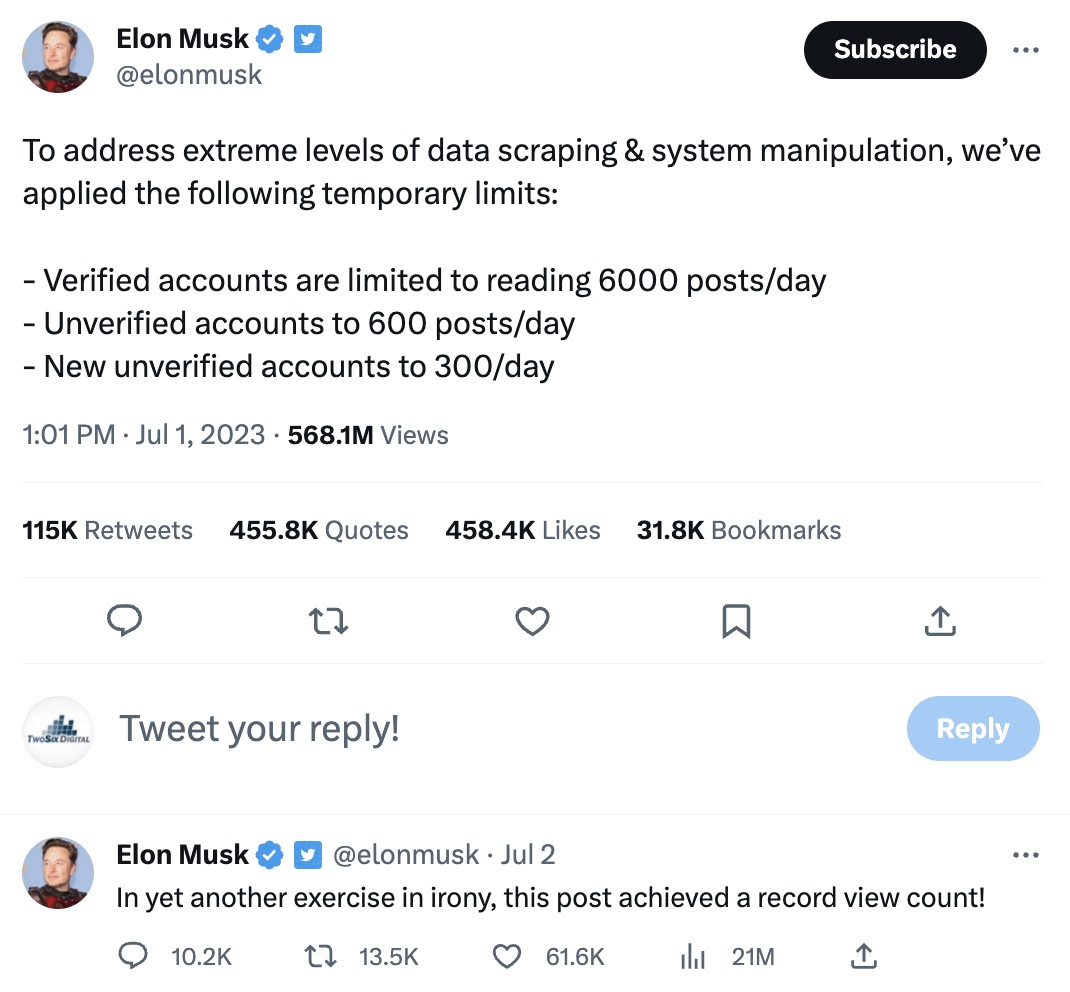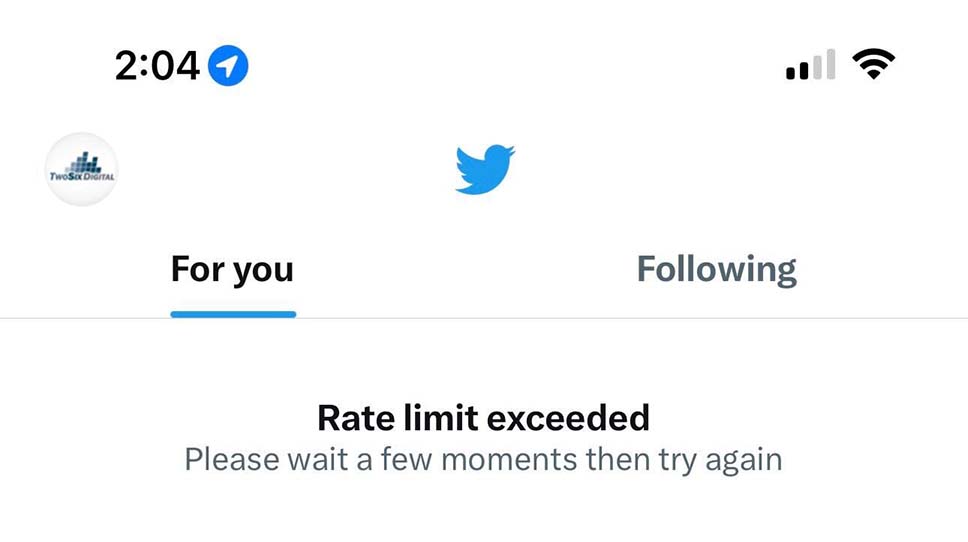The TwoSix team is here to share what’s On Our Radar for July so that you can stay ahead of the always-evolving digital marketing landscape. This month our team discusses Apple Business Connect, YouTube’s potential takeover, the fall of Twitter, the rise of Threads, and so much more! Keep reading to find out what we’re keeping On Our Radar for July 2023.

We have talked about the importance of Google Business listings over the last few years, and recently, Apple has entered the market to help customers find your business on Apple Maps.
Apple Business Connect is a place card accessible to everyone who uses Apple devices and the built-in apps with directions and contact information. It has a very similar look to the Google Business listings and also allows you to do updates with special announcements, promotions and offers. You can even add an integrated reservation link for hotels or restaurants.
Learn about setting up your Apple Business Connect listing here!

We’ve said it before, and we’ll say it again. If you’re not giving some love to your organization’s YouTube Channel, now is the time to get a coordinated plan into action. YouTube seems to be luring in content creators from the competition (TikTok mainly) with lower Partner Program eligibility thresholds and better monetization options. Where the money goes, the creators go. Where the creators go, so will the audience. This could mean a big uptick in YouTube’s prominence in the realm of vertical videos with their Shorts format. Pay attention to this. I think it’s just a matter of time before YouTube owns the vertical video space.
Getting started on YouTube doesn’t have to be a big lift for your day-to-day efforts either. You simply need to build the network into your current content plan. That’s something that we rarely see when working with DMOs!
To get started shoot for the following:
- Upload one long-form video per month: 30 seconds to 4 minutes will do!
- Make a video about your most popular blog post (or landing page) from the last month according to your Google Analytics.
- Include directional language in the video and its description to move users to the long-form content (don’t forget video cards!)
- Integrate that video into the blog post for more longtail consumption of the video
- Don’t forget that you can lean into your past content too. You don’t have to start from scratch. A quick re-edit counts too! Maybe try remove that annoying music bed and re-edit with a narration!
- Try to do at least two YouTube Shorts per week: 60 seconds is all you get, so make it count.
- One of your Shorts could be a teaser for the month’s long-form video
- Try to use spoken words rather than sounds in your Shorts for added context
- Keep it snappy by using one sentence of dialog per shot in the Short
- Start leveraging YouTube Posts: Try to get at least 2 Posts up per week.
- Again, use posts as a teaser for your upcoming content
- Use a compelling image
- Test out the different options like polls or featuring an older video that still has relevance
At the end of the day, you simply need a plan to finally start to leverage the world’s second-largest search engine and soon-to-be vertical video kingpin. Simply start by leveraging analytics to identify an impactful theme, build content that supports and enhances that content, and then simply leverage “The 5 Rule” to get it out to the world. Remember, you can upload your Shorts to Reels and TikTok to hit multiple birds with one stone. Just be sure to remove the watermark! That’s called working smarter and not harder! Make it happen.

Since Elon Musk bought Twitter in October 2022 for $44 billion, things have been… a bit chaotic. From replacing the bird logo with the Doge meme for 4 days to the Twitter Blue subscription making Twitter “worse than ever”, it’s been a wild ride.
But now, it can literally become unusable for some users… every day.
On July 1st, 2023, Elon announced the new Twitter Rate limits. Essentially, this means that Twitter users can only look at a certain number of tweets per day, depending on a few factors. The average non-paying user can now view 1,000 tweets a day. Among other things, Musk is concerned that AI companies are scrapping Twitter’s data to build their tech, such as Chat GPT, for free. This rate limits help prevent that.

While 1K tweets sounds like a lot, the day this initiative was launched, thousands of users reported problems viewing content. Additionally, it’s unclear what counts as looking: scrolling past tweets, looking at replies, checking your mentions, etc. It’s problematic.

What this “rate limit” means for the average digital marketer is that there’s another thing that makes Twitter harder to use. Personally, I’ve had to be very careful every day so far in July to avoid going over my rate limit. I’ve seen countless users complaining. It makes me, and others, use Twitter less.
In the last few months, I’ve also noticed that only Twitter Blue subscribers get their replies anywhere near the top of threads. The quality of content has gone down a lot. If you haven’t already, this might be a good time to consider moving on from this platform or slowing down your efforts. In my opinion, it feels like Twitter is going by the wayside.

Ready to spruce up your LinkedIn ads and posts? Getting users to stop scrolling is key so engaging text or visuals that stand out from the rest are paramount. Using bold statements or questions to get users to engage with the post are always good ideas. Telling a success story about an individual or business in your post can connect with an audience and drive engagement. Short and concise headlines usually lead to higher engagement. 100- 150 characters is a good number to aim for in order to really grab attention and drive clicks. If you struggle with shortening your text, use ChatGPT to help you or use it to come up with some copy variants. Using intriguing photos that are eye catching, unique and relevant to the post can create excellent engagement. Remember that when creating intriguing and engaging content it’s important to engage as well, respond to comments, even the negative ones. By using just a few of these tips, you will really be able to up your LinkedIn game!
TIKTOK EXPANDS ACCESS TO CREATOR MARKETPLACE

TikTok has lowered the ad spend threshold for the creator market place! Wait…what does that even mean?
First things first, let’s define what the ‘marketplace’ is. The TikTok creator marketplace is a powerful tool for brands and TikTok creators to discover one another, establish connections, and foster mutually beneficial relationships. Advertisers can dive into this marketplace to find suitable creators (think micro-influences) whose personal brand aligns with their advertising and branding requirements. Together, they can collaborate on compelling video content tailored for advertising purposes. What sets this marketplace apart from traditional brand-influencer relationships is that TikTok manages the entire process, allowing advertisers access based on their ad spend rather than directly paying the influencers (handled instead by the platform à-la YouTube).
Initially, when this tool was introduced, advertisers had to invest a hefty $20,000 for a single campaign to gain access to the marketplace. However, with the tool’s increasing popularity and usage, TikTok has significantly lowered the threshold to just $2,000. This revised threshold empowers small and mid-sized businesses to take advantage.
For brands struggling to generate content and establish a presence on the platform, collaborating with a relevant creator can act as a launchpad, propelling their initial content creation efforts and helping them carve out a distinctive voice within the network. Instead of blindly spending their budget, hoping for favorable outcomes, advertisers can strategically allocate their resources towards paid promotions for these videos, guaranteeing visibility among their desired audience.
In essence, the TikTok creator marketplace revolutionizes the brand-creator dynamic, opening doors to creative synergies and unlocking growth opportunities. Whether you’re a small brand just starting out or an established advertiser, leveraging this platform can be a game changer for your TikTok presence.

Meta’s Twitter clone, Threads, had tremendous success with 30 million sign-ups within the first 24 hours of its launch, positioning it to potentially become the fastest-growing consumer app ever. This record is currently held by ChatGPT, which achieved 100 million active users in two months.
A big contributing factor to this growth is that Threads allows users to connect their existing Instagram accounts. This helped to attract early adopters such as celebrities and brands. When joining for the first time, all you have to do is log into your already existing Instagram account and your profile picture will be automatically transferred. For even more convenience, Threads allows you to follow people you already know from Instagram immediately after creating your account. However, Threads differs from Twitter in several ways.
Threads lacks a reverse-chronological feed, hashtag and keyword search functions, and direct messaging capabilities. Many users have already expressed their dislike for the seemingly random Threads feed. While Meta faces legal threats from Twitter over alleged employee poaching, the company denies these claims. The future success of Threads remains uncertain, with possibilities ranging from becoming a Twitter-killer to just being a less engaging version of Instagram.

Google announced new brand settings that make it easier for advertisers to control what branded search terms they bid on. It’s a small change, and possibly an overlooked one, but this feature makes it easier to manage branded keywords and reduce needless spending.
In the past, if you weren’t too careful, the Google Ads algorithm could automatically bid on keywords that aren’t useful for your business, wasting money on users who aren’t going to engage with you. For example, if you are a CVB looking to advertise a handful of partner restaurants, you probably want to bid on restaurant keywords like “best restaurants near me.” The algorithm could think that this meant you also want to show your ads to people searching “McDonald’s near me” or people who directly search for non-partner restaurants.
Now, the new brand settings make it so you simply type in the names of brands you want to include in your advertisements, and with a flip of a switch, your ads will never show up for any brands not on your list, without the need for exact match keywords, negative keywords or any other tedium.
It’s not too flashy, but it’s nice to see Google making it easier for advertisers to stretch their dollar.
With the ever-changing digital marketing world, we are here to keep you informed of new digital trends and what we are keeping on our radar for July 2023. Have any questions? Contact us! We’re here to help.
Make sure to subscribe to our newsletter to stay in the loop on all things TwoSix Digital.










